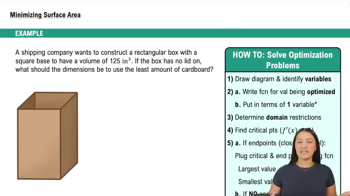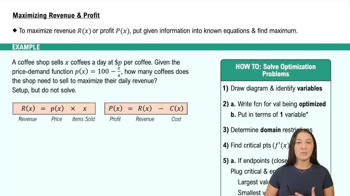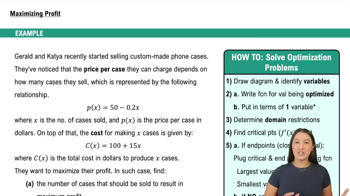Table of contents
- 0. Functions7h 52m
- Introduction to Functions16m
- Piecewise Functions10m
- Properties of Functions9m
- Common Functions1h 8m
- Transformations5m
- Combining Functions27m
- Exponent rules32m
- Exponential Functions28m
- Logarithmic Functions24m
- Properties of Logarithms34m
- Exponential & Logarithmic Equations35m
- Introduction to Trigonometric Functions38m
- Graphs of Trigonometric Functions44m
- Trigonometric Identities47m
- Inverse Trigonometric Functions48m
- 1. Limits and Continuity2h 2m
- 2. Intro to Derivatives1h 33m
- 3. Techniques of Differentiation3h 18m
- 4. Applications of Derivatives2h 38m
- 5. Graphical Applications of Derivatives6h 2m
- 6. Derivatives of Inverse, Exponential, & Logarithmic Functions2h 37m
- 7. Antiderivatives & Indefinite Integrals1h 26m
- 8. Definite Integrals4h 44m
- 9. Graphical Applications of Integrals2h 27m
- 10. Physics Applications of Integrals 2h 22m
5. Graphical Applications of Derivatives
Applied Optimization
Problem 4.3.108
Textbook Question
{Use of Tech} Growth rate of spotted owlets The rate of growth (in g/week) of the body mass of Indian spotted owlets is modeled by the function r(t) = 10,147.9e⁻²·²ᵗ/(37.98e⁻²·² + 1), where t is the age (in weeks) of the owlets. What value of t > 0 maximizes r? What is the physical meaning of the maximum value?
 Verified step by step guidance
Verified step by step guidance1
To find the value of t that maximizes the growth rate function r(t), we need to find the critical points of the function. This involves taking the derivative of r(t) with respect to t and setting it equal to zero.
The function given is r(t) = \( \frac{10,147.9e^{-2.2t}}{37.98e^{-2.2} + 1} \). We will use the quotient rule to differentiate this function. The quotient rule states that if you have a function \( \frac{u(t)}{v(t)} \), its derivative is \( \frac{u'(t)v(t) - u(t)v'(t)}{(v(t))^2} \).
Identify u(t) and v(t) from the function: \( u(t) = 10,147.9e^{-2.2t} \) and \( v(t) = 37.98e^{-2.2} + 1 \). Differentiate both: \( u'(t) = -22,325.38e^{-2.2t} \) and \( v'(t) = 0 \) since v(t) is a constant with respect to t.
Substitute u(t), u'(t), v(t), and v'(t) into the quotient rule formula to find r'(t). Simplify the expression to find the critical points by setting r'(t) = 0.
Solve the equation obtained from setting r'(t) = 0 to find the value of t that maximizes r(t). The physical meaning of the maximum value of r(t) is the age at which the growth rate of the owlets' body mass is at its highest.
 Verified video answer for a similar problem:
Verified video answer for a similar problem:This video solution was recommended by our tutors as helpful for the problem above
Video duration:
6mPlay a video:
Was this helpful?
Key Concepts
Here are the essential concepts you must grasp in order to answer the question correctly.
Differentiation
Differentiation is a fundamental concept in calculus that involves finding the derivative of a function. The derivative represents the rate of change of a function with respect to its variable. In this context, differentiating the growth rate function r(t) will help identify the value of t that maximizes the growth rate of the spotted owlets.
Recommended video:

Finding Differentials
Critical Points
Critical points occur where the derivative of a function is zero or undefined. These points are essential for determining local maxima and minima of the function. By finding the critical points of the growth rate function r(t), we can ascertain the age of the owlets that maximizes their growth rate.
Recommended video:

Critical Points
Second Derivative Test
The second derivative test is a method used to determine the concavity of a function at its critical points. If the second derivative is positive at a critical point, the function has a local minimum; if negative, it has a local maximum. Applying this test to the growth rate function will confirm whether the identified critical point corresponds to a maximum growth rate for the owlets.
Recommended video:

The Second Derivative Test: Finding Local Extrema

 1:13m
1:13mWatch next
Master Intro to Applied Optimization: Maximizing Area with a bite sized video explanation from Callie
Start learningRelated Videos
Related Practice









